7-2 Uranus and Neptune have seemingly quiet atmospheres
Even through a large, backyard telescope, both Uranus and Neptune are dim, mostly uninspiring sights. Each planet appears as a hazy, featureless disk with a faint greenish-blue tinge, with Uranus being a bit greener and Neptune being slightly bluer. Although Uranus and Neptune are both about 4 times larger in diameter than Earth, they are so distant that their angular dimensions as seen from Earth are tiny. To an Earth-based observer, Uranus is roughly the size of a golf ball seen at a distance of 1 mi (1.6 km), and Neptune, being 2 times farther away, appears to be about half that size.
From 2007 through 2011, Uranus and Neptune were less than 40° apart in the sky in the adjacent constellations of Pisces, Aquarius, and Capricornus (the Sea Goat). During these years, the two planets were at opposition in either August or September, which were thus the best months to view them with a telescope. How are these planets similar and how are they different?
Uranus’s Atmosphere
Only one space probe has ever visited Uranus. Scientists had hoped that Voyager 2 would reveal cloud patterns in Uranus’s atmosphere when it flew past the planet in January 1986. But even images recorded at close range showed Uranus to be remarkably featureless (Figure 7-9). Faint cloud markings became visible in images of Uranus only after extreme computer enhancement (Figure 7-10).
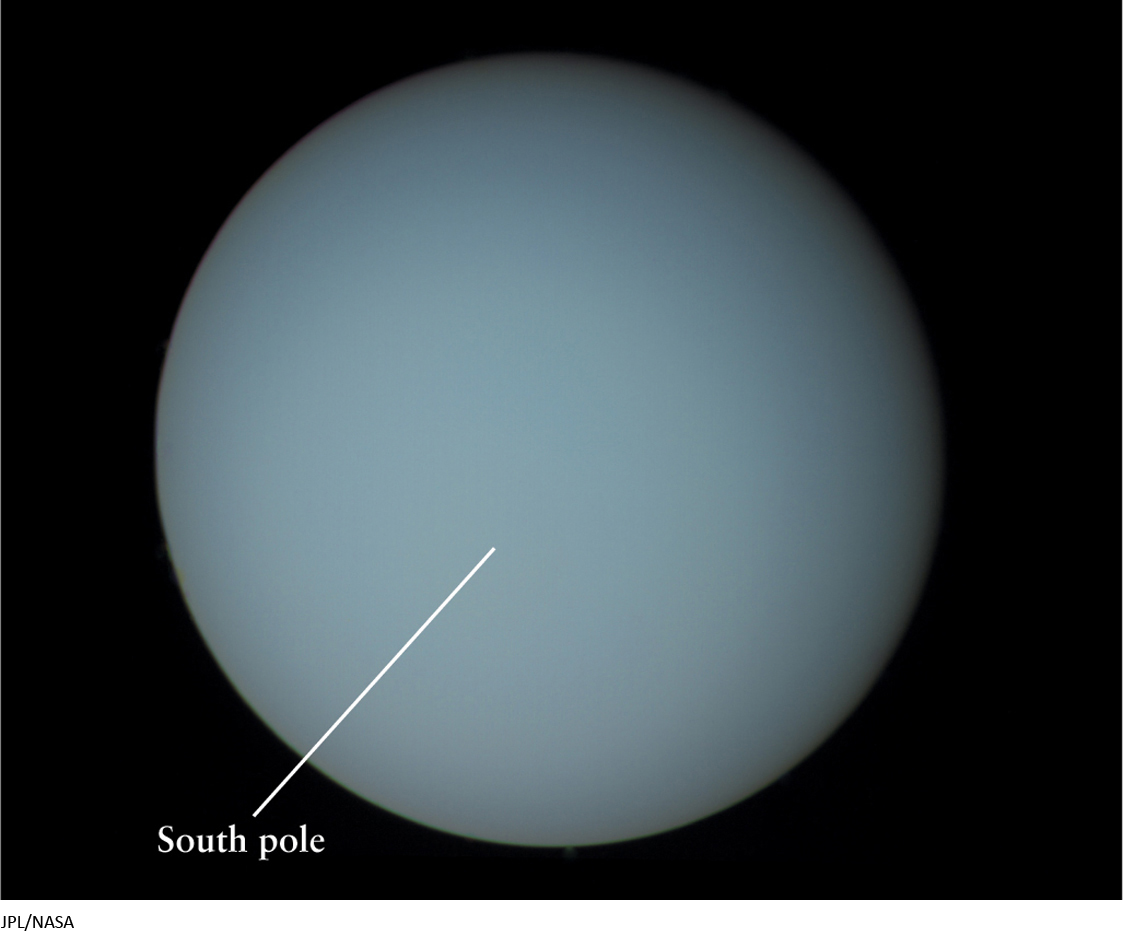

174
Voyager 2 data confirmed that the Uranian atmosphere is dominated by hydrogen (82.5%) and helium (15.2%), similar to the atmospheres of Jupiter and Saturn. Uranus differs, however, in that 2.3% of its atmosphere is methane (CH4), which is 5 to 10 times the percentages found on Jupiter and Saturn. In fact, Uranus has a higher percentage of all heavy elements—including carbon atoms, which are found in molecules of methane—than do Jupiter and Saturn.
Methane preferentially absorbs the longer wavelengths of visible light, so sunlight reflected from Uranus’s upper atmosphere is depleted of its reds and yellows. This gives the planet its distinct greenish-blue appearance. Ultraviolet light from the Sun turns some of the methane gas into a hydrocarbon haze, making it difficult to see the lower levels of the atmosphere.
Uranus and Neptune receive so little of the Sun’s energy, astronomers were surprised to see any weather patterns in their atmospheres.
Ammonia (NH3), which constitutes 0.01% to 0.03% of the atmospheres of Jupiter and Saturn, is almost completely absent from the Uranian atmosphere. The reason is that Uranus is colder than Jupiter or Saturn: The temperature in its upper atmosphere is only −360°F (−218°C = 55 K). Ammonia freezes at these very low temperatures, so any ammonia has long since precipitated out of the atmosphere and into the planet’s interior. For the same reason, Uranus’s atmosphere is also lacking in water. Hence, the substances that make up the clouds on Jupiter and Saturn—ammonia, ammonium hydrosulfide (NH4SH), and water—are not available on Uranus. This helps to explain the bland, uniform appearance of the planet shown in Figure 7-9.
The few clouds found on Uranus are made primarily of methane, which condenses into droplets only if the pressure is sufficiently high. Because methane clouds form only at lower levels within the atmosphere, they are difficult for us to see.
By following the motions of clouds and storm systems on Uranus, scientists find that the planet’s winds flow to the east—that is, in the same direction as the planet’s rotation—at northern and southern latitudes, but to the west near the equator. This is quite unlike the situation on Jupiter and Saturn, where the zonal winds alternate direction many times between the north and south poles. The fastest Uranian winds (about 440 mi/h, or 700 km/h) are found at the equator.
Although Uranus’s equatorial region was receiving little sunlight at the time of the Voyager 2 flyby, the atmospheric temperature there (about −359°F = −218°C = 55 K) was not too different from that at the sunlit pole. Heat must therefore be efficiently transported from the poles to the equator. This north-south heat transport, which is perpendicular to the wind flow, may have mixed and homogenized the atmosphere to make Uranus nearly featureless.
Question
ConceptCheck 7-5: If methane were absent from Uranus’s atmosphere, what color would it appear?
Neptune Is a Cold, Bluish World with Jupiterlike Atmospheric Features
At first glance, Neptune appears to be the twin of Uranus, but these two planets are by no means identical. While Neptune and Uranus have almost the same diameter, Neptune is 18% more massive. As with Uranus, only one space probe has ever visited Neptune. When Voyager 2 flew past Neptune in August 1989, it revealed that the planet has a more active and dynamic atmosphere than Uranus. This activity suggests that Neptune, unlike Uranus, has a powerful source of energy in its interior.
The Voyager 2 data showed that Neptune has essentially the same atmospheric composition as Uranus: 79% hydrogen, 18% helium, 3% methane, and almost no ammonia or water vapor. As for Uranus, the presence of methane gives Neptune a characteristic bluish-green color. The temperature in the upper atmosphere is also the same as on Uranus, about 55 K. That this should be so, even though Neptune is much farther from the Sun, is further evidence that Neptune has a strong internal heat source.
175
Unlike Uranus, however, Neptune has clearly visible cloud patterns in its atmosphere. At the time that Voyager 2 flew past Neptune, the most prominent feature in the planet’s atmosphere was a giant storm called the Great Dark Spot (Figure 7-11). The Great Dark Spot had a number of similarities to Jupiter’s Great Red Spot. The storms on both planets were comparable in size to Earth’s diameter, both appeared at about the same latitude in the southern hemisphere, and the winds in both storms circulated in a counterclockwise direction (see Figure 7-5). But Neptune’s Great Dark Spot appears not to have been as long-lived as the Great Red Spot on Jupiter. When the Hubble Space Telescope first viewed Neptune in 1994, the Great Dark Spot had disappeared. Another dark storm appeared in 1995 in Neptune’s northern hemisphere.
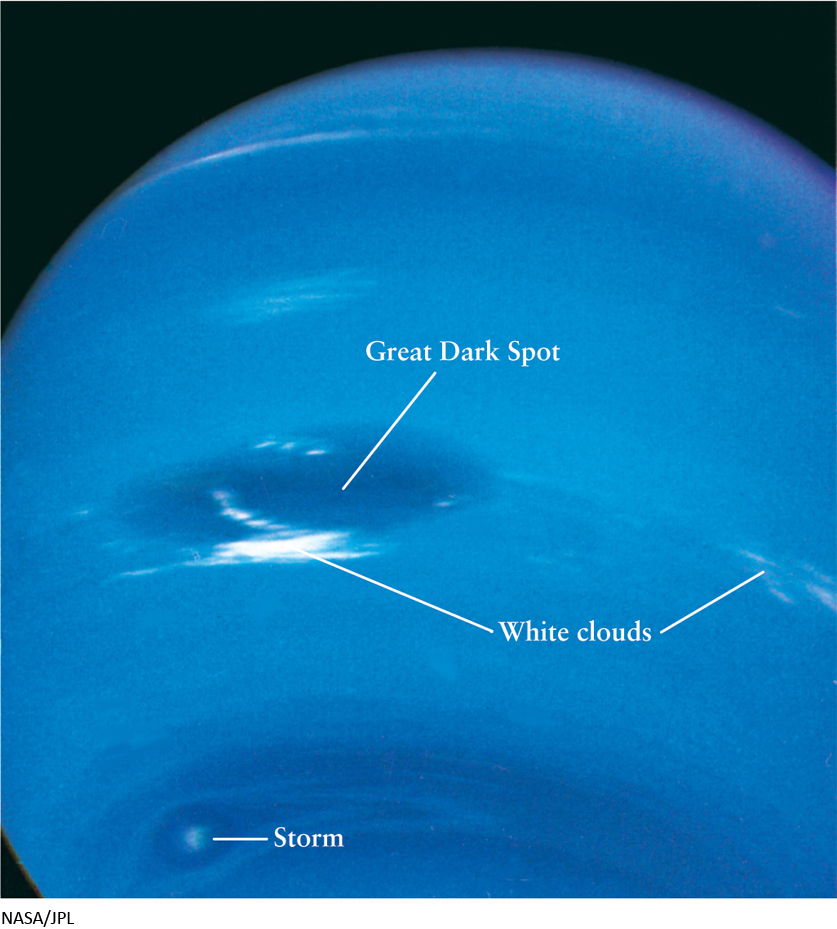
Voyager 2 also saw a few conspicuous whitish clouds on Neptune. These clouds are thought to be produced when winds carry methane gas into the cool, upper atmosphere, where it condenses into crystals of methane ice. Voyager 2 images show these high-altitude clouds casting shadows onto lower levels of Neptune’s atmosphere (Figure 7-12). Images from the Hubble Space Telescope also show the presence of high-altitude clouds (Figure 7-13).
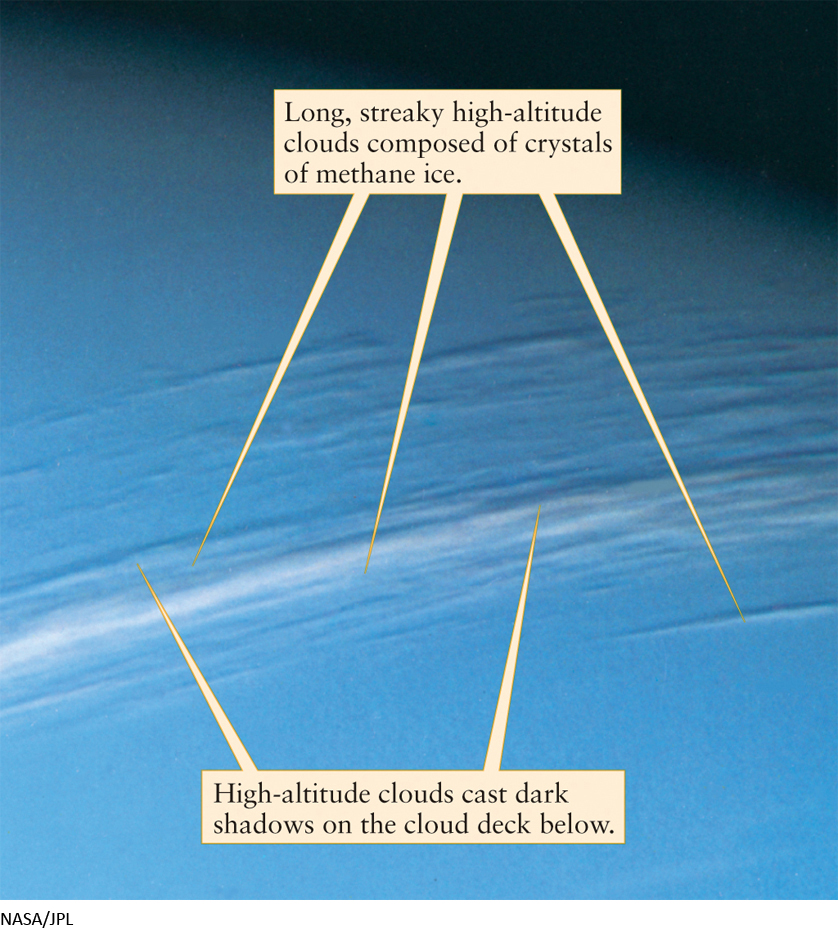
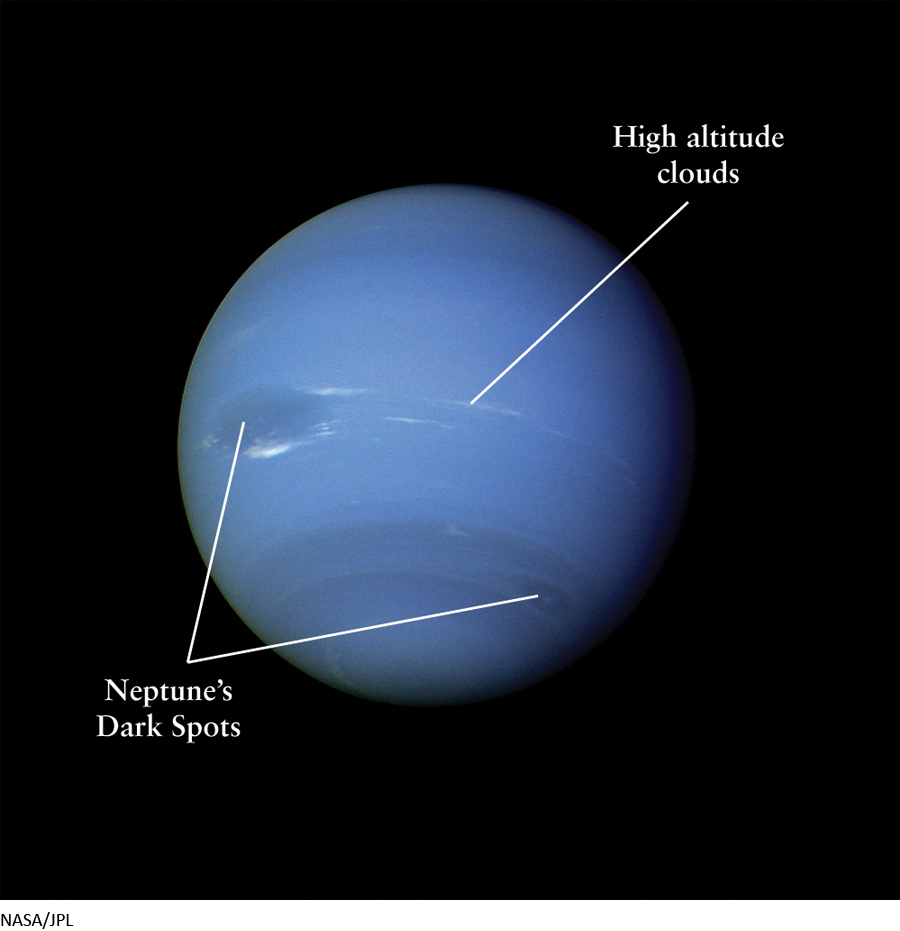
Thanks to its greater distance from the Sun, Neptune receives less than half as much energy from the Sun as Uranus. But with less solar energy available to power atmospheric motions, why are there high-altitude clouds and huge, dark storms on Neptune but not on Uranus? At least part of the answer is probably that Neptune is still slowly contracting, thus converting gravitational energy into thermal energy that heats the planet’s core. (The same is true for Jupiter and Saturn.) The evidence for this is that Neptune, like Jupiter and Saturn but unlike Uranus, emits more energy than it receives from the Sun. The combination of a warm interior and a cold outer atmosphere can cause convection in Neptune’s atmosphere, producing the up-and-down motion of gases that generates clouds and storms. Neptune also resembles Jupiter in having faint belts and zones parallel to the planet’s equator (see Figure 7-13).
176
Like those on Uranus, most of Neptune’s clouds are probably made of droplets of liquid methane. Because these droplets form fairly deep within the atmosphere, the clouds are more difficult to see than the ones on Jupiter. Hence, Neptune’s belts and zones are less pronounced than Jupiter’s, although more so than those on Uranus (thanks to the extra cloud-building energy from Neptune’s interior). As described above, Neptune’s high-altitude clouds (see Figure 7-12) are probably made of frozen methane.
 Go to Video 7-2
Go to Video 7-2
Figure 7-14 shows one model for the present-day internal structures of Uranus and Neptune. In this model each planet has a rocky core roughly the size of Earth, although more massive. Each planet’s core is surrounded by a mantle of liquid water and ammonia. (This means that the mantle is chemically similar to household window cleaning fluid.) Around the mantle is a layer of liquid molecular hydrogen and liquid helium, with a small percentage of liquid methane. This layer is relatively shallow compared to those on Jupiter and Saturn, and the pressure is not high enough to convert the liquid hydrogen into liquid metallic hydrogen. The figures in Cosmic Connections: The Outer Planets: A Comparison summarize the key properties of Uranus and Neptune and how they compare with those of Jupiter and Saturn.
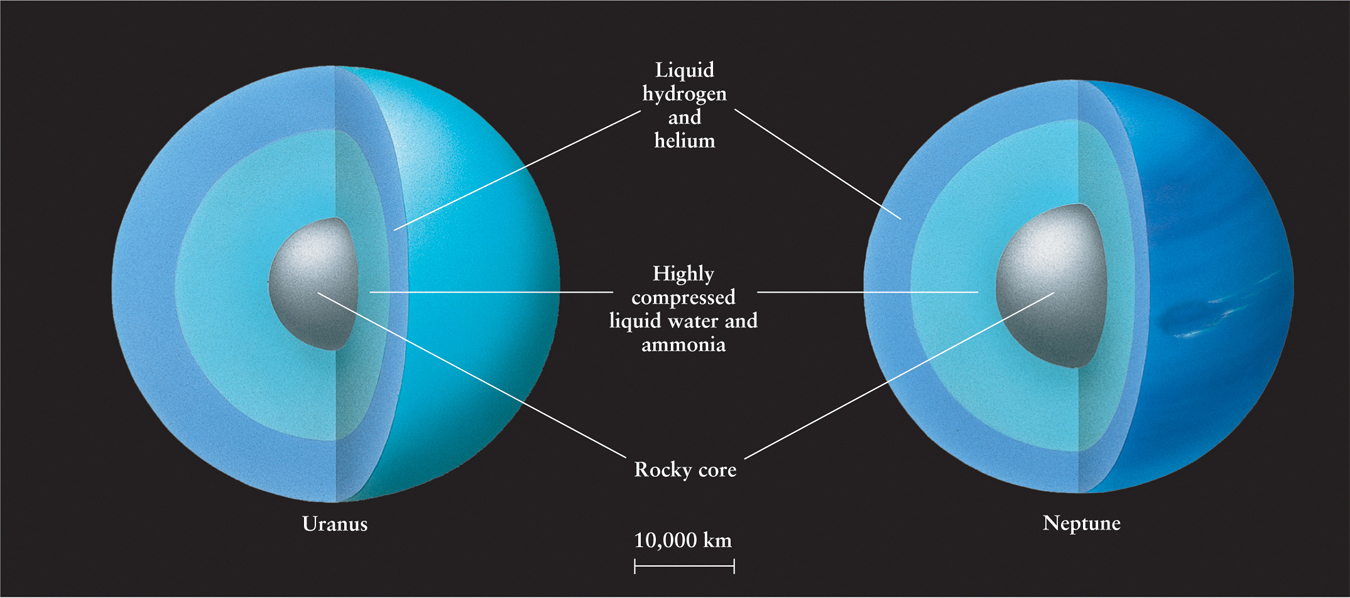
Question
ConceptCheck 7-6: Why would scientists be surprised that Neptune had active belts and zones, unlike Uranus?